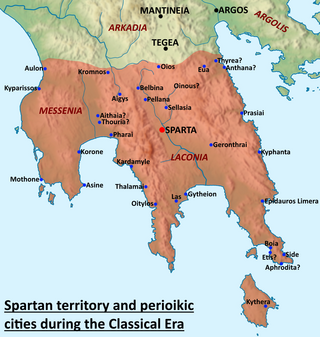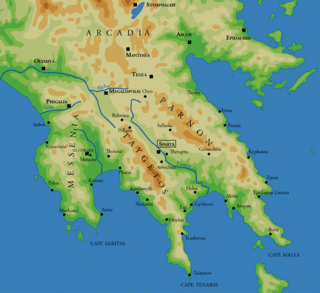
The Apega of Nabis, also known as the Iron Apega, was described by Polybius [1] as an ancient torture device similar to the iron maiden. It was invented by Nabis, a king who ruled Sparta as a tyrant from 207 to 192 BC.

The Apega of Nabis, also known as the Iron Apega, was described by Polybius [1] as an ancient torture device similar to the iron maiden. It was invented by Nabis, a king who ruled Sparta as a tyrant from 207 to 192 BC.
The mechanical Apega, according to Polybius, was a machine, a well-executed replica of the real wife of Nabis, and was used by Nabis to collect money from unwilling Spartan citizens. Those who did not give money were sent to deal with his wife. This was the replica, dressed in expensive clothing, with arms outstretched. When the drunken visitors hugged her, this triggered the arms to close. The device's arms, hands, and breasts were covered with iron nails, and the arms were capable of crushing the body of its victim. Nabis would control the machine through hidden devices until the victim agreed to pay a tribute or to the point of death.
The automaton, Apega, was one of the advances in technology of the ancient Greco-Roman world used as implements of torture, along with other torture devices such as the cross, the wheel, and the brazen bull of Phalaris. [2]
Nabis, tyrant of Sparta, reportedly created the device in the image of his own wife, Apega (Ancient Greek : Ἀπήγα; also known as Ἀγαπήνα or Ἀπία), a tyrant herself who helped in furthering her husband's ambitions. The Greek historian Polybius (203–120 BC, author of The Histories ) further described the real Queen Apega as a female ruler who ruled Sparta like a Hellenistic queen, similar to Cleopatra and Arsinoe, because she "received men at court alongside her husband." Polybius also mentioned that she was a woman who knew how to dishonor men by humiliating women belonging to the families of male citizens. Both Nabis and Apega brought suffering and violence to their subjects by stealing their wealth and valuables. [3]
The historical Apega was described as a Spartan woman who had exceeded her husband's viciousness and wielded power to satisfy her own greed. [3] The Iron Apega was further described as the personification of the evil and deceitfulness of the real Apega and was said to be equal to Pandora, the first woman in Greek mythology. [3]
In Arthur Machen's episodic horror novella The Three Impostors (1895), one story centers on an execution device named the "Iron Maid", which in its outstretched arms bears a great resemblance to the Iron Apega. [4] Nabis and Apega are mentioned in Adrienne Mayor’s “Gods and Robots”. [5]

Sparta was a prominent city-state in Laconia in ancient Greece. In antiquity, the city-state was known as Lacedaemon, while the name Sparta referred to its main settlement on the banks of the Eurotas River in the Eurotas valley of Laconia, in south-eastern Peloponnese. Around 650 BC, it rose to become the dominant military land-power in ancient Greece.
This article concerns the period 199 BC – 190 BC.

Ancient Greece was a northeastern Mediterranean civilization, existing from the Greek Dark Ages of the 12th–9th centuries BC to the end of classical antiquity, that comprised a loose collection of culturally and linguistically related city-states and other territories. Most of these regions were officially unified only once, for 13 years, under Alexander the Great's empire from 336 to 323 BC. In Western history, the era of classical antiquity was immediately followed by the Early Middle Ages and the Byzantine period.

Tyche was the presiding tutelary deity who governed the fortune and prosperity of a city, its destiny. In Classical Greek mythology, she is usually the daughter of the Titans Tethys and Oceanus, or sometimes Zeus, and at this time served to bring positive messages to people, relating to external events outside their control.

The iron maiden is a ancient torture device, consisting of a solid iron cabinet with a hinged front and spike-covered interior, sufficiently tall to enclose a human being. The first stories citing the iron maiden were composed in the 19th century. The use of iron maidens is considered to be a myth, heightened by the belief that people of the Middle Ages were uncivilized; evidence of their actual use has never been found. They have become a popular image in media involving the Middle Ages and involving torture chambers.

Cleomenes III was one of the two kings of Sparta from 235 to 222 BC. He was a member of the Agiad dynasty and succeeded his father, Leonidas II. He is known for his attempts to reform the Spartan state.

Nabis was the last king of independent Sparta. He was probably a member of the Heracleidae, and he ruled from 207 BC to 192 BC, during the years of the First and Second Macedonian Wars and the eponymous "War against Nabis", i.e. against him. After taking the throne by executing two claimants, he began rebuilding Sparta's power. During the Second Macedonian War, Nabis sided with King Philip V of Macedon and in return he received the city of Argos. However, when the war began to turn against the Macedonians, he defected to Rome. After the war, the Romans, urged by the Achaean League, attacked Nabis and defeated him. He then was assassinated in 192 BC by the Aetolian League. He represented the last phase of Sparta's reformist period.
Laconophilia is love or admiration of Sparta and of the Spartan culture or constitution. The term derives from Laconia, the part of the Peloponnesus where the Spartans lived.

Philopoemen was a skilled Greek general and statesman, who was Achaean strategos on eight occasions.

Areus I was Agiad King of Sparta from 309 to 265 BC. His reign is noted for his attempts to transform Sparta into an Hellenistic kingdom and to recover its former pre-eminence in Greece, notably against the kings Antigonos Gonatas of Macedonia and Pyrrhus of Epirus.

Leonidas II was the 28th Agiad King of Sparta from 254 to 242 BC and from 241 to 235 BC.

The siege of Gythium was fought in 195 BC between Sparta and the coalition of Rome, Rhodes, the Achaean League, and Pergamum. As the port of Gythium was an important Spartan base, the allies decided to capture it before they advanced inland to Sparta. The Romans and the Achaeans were joined outside the city by the Pergamese and Rhodian fleets. The Spartans held out, but one of the joint commanders, Dexagoridas, decided to surrender the city to the Roman legate. When Gorgopas, the other commander, found out, he killed Dexagoridas and took sole command of the city. After Dexagoridas' murder, the Spartans held out more vigorously. However, Titus Quinctius Flamininus of the allied forces arrived with 4,000 more men and the Spartans decided to surrender the city on the condition that the garrison could leave unharmed. The result of this siege forced Nabis, the tyrant of Sparta, to abandon the surrounding land and withdraw to the city of Sparta. Later that year, Sparta capitulated to the allies.

The Laconian War of 195 BC was fought between the Greek city-state of Sparta and a coalition composed of Rome, the Achaean League, Pergamum, Rhodes, and Macedon.
Apega may refer to:
Spartan women were famous in ancient Greece for seemingly having more freedom than women elsewhere in the Greek world. To contemporaries outside of Sparta, Spartan women had a reputation for promiscuity and controlling their husbands. Spartan women could legally own and inherit property, and they were usually better educated than their Athenian counterparts. The surviving written sources are limited and largely from a non-Spartan viewpoint. Anton Powell wrote that to say the written sources are "'not without problems'... as an understatement would be hard to beat".
Laconicus was a Spartan of royal descent who appears as king of Sparta for a brief moment in the aftermath of the assassination of the tyrant Nabis in 192 BC. Little is known about him; even his name may not be correct.

The status and characteristics of ancient and modern-day women in Greece evolved from the events that occurred in the history of Greece. According to Michael Scott, in his article "The Rise of Women in Ancient Greece", "place of women" and their achievements in ancient Greece was best described by Thucidydes in this quotation: that "The greatest glory [for women] is to be least talked about among men, whether in praise or blame." However, the status of Greek women has undergone change and more advancement upon the onset of the twentieth century. In 1952, they received their right to vote, which led to their earning places and job positions in businesses and in the government of Greece; and they were able to maintain their right to inherit property, even after being married.
Apia of Sparta, also found as Apega in older literature, was a Queen of Sparta.
Chaeron was a Lacedaemonian (Spartan) demagogue who briefly served as tyrant of Sparta in 180 BC.